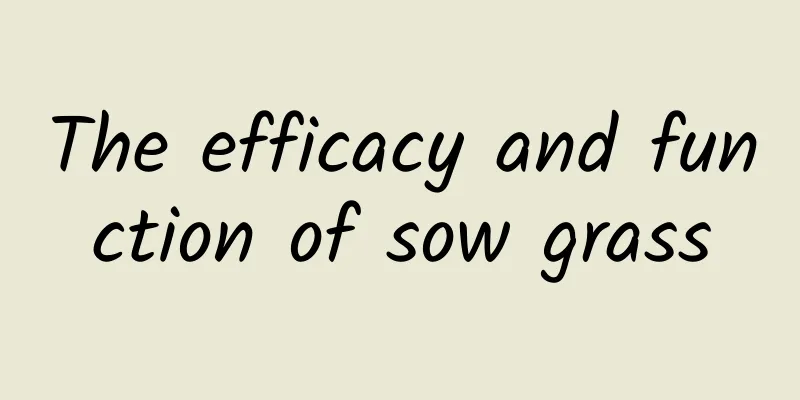The efficacy and function of sow grass

|
Sow grass is a very nutritious and precious medicinal material. Eating sow grass regularly can have very good effects and functions. So how should we eat sow grass? What specific benefits can eating sow grass bring to our body? We need to understand some professional knowledge of sow grass to answer these questions. 【Other name】 Coptis chinensis [Source] Medicinal material source: The root of the Ranunculaceae plant. [Original morphology] Ear-shaped herringbone fruit, perennial upright herb, glabrous. The rhizome is horizontal, dark brown, hard, and has many fine roots. There are few basal leaves, which often wither during the fruiting period; the petiole is 5-11cm long; the leaves are bivalve-shaped compound leaves; the central finger segment is rhombic, 1.8-6cm long, 1.5-5cm wide, with shallow teeth in the upper and middle parts; the lateral finger segments have 2 leaflets, the leaflets are of unequal size, the upper leaflets are obliquely ovate, and the lower leaflets are obliquely ovate; there are 2-4 stem leaves, similar to the basal leaves; the petiole is 2-5cm long. Complex monochasium, 7-19cm long, with 1-7 flowers; lower bracts leaf-like; pedicels 2.5-3.5cm long; flowers bisexual, sepals 5, petal-like, white, obovate, elliptical, 5-9mm long, 3-5.5mm wide, with blunt apex; petals 5, golden yellow, about 4mm long, lobes obovate, 1.5mm long and wide, apex slightly concave or entire, with slender flutter at the bottom; stamens about 20, 5-6mm long, anther 0.6mm; carpels 2, fused at the base. Follicles 2, narrowly obovate-lanceolate, 11-15 mm long, forked, with beak about 2 mm long. The seeds are 8-9 in long, nearly round, about 1 mm in diameter, and yellowish brown. The flowering period is April-May, and the fruiting period is May-June. [Habitat distribution] Ecological environment: Grown in moist places in the shade of mountains, or beside rocks under sparse forests. 【Nature and flavor】 Bitter; cold 【Functions and indications】 Clears away heat and dampness; detoxifies and resolves stagnation; relieves cough and resolves phlegm. It is used to treat damp-heat jaundice, carbuncle, sore, scrofula, phlegm-heat cough and epilepsy. [Usage and Dosage] For oral use: decocted in water, 3-10g. For external use: take appropriate amount and mash it for application. 【Excerpt】 Chinese Materia Medica The above content is an introduction to the effects and functions of the traditional Chinese medicine sow grass. I hope it can bring you some help. The culture of traditional Chinese medicine is profound and extensive. When treating diseases, we need to choose different medicines according to the different diseases to better help the body relieve troubles. |
<<: The efficacy and function of hydrangea bulbs
>>: The efficacy and function of sow vegetable
Recommend
The efficacy and function of lantern fruit
Lantern fruit is a common type of traditional Chi...
After listening to the "gambler's" warning, I learned how to edit photos and make the camera turn.
From Grand Theft Auto, The Witcher 3 to Red Dead ...
Four national departments jointly issued a document, stating that these examinations in hospitals will no longer need to be repeated!
Four national departments jointly issued a docume...
What are the medicinal values of Shengdi?
Shengdi is quite common in our lives, mainly beca...
What is calamus?
As various delicacies continue to infiltrate peop...
The efficacy and function of sea sand
The treatment of diseases requires a good method....
The efficacy and function of short-stamen longevity bamboo
Short-stamen bamboo is a common Chinese medicine ...
International Day of Persons with Disabilities | We may be different, but we can all…
Producer: Chen Kaixing, Zou Shengwen Producer: Yu...
The efficacy and function of sow vine
There are so many medicinal herbs in the world, a...
A "new era" for bridges! The world's largest span arch bridge, Tian'e Longtan Bridge, is completed and opened to traffic
On February 1, the world's largest span rigid...
If your blood sugar level after a meal is higher than this value, you have diabetes! Many people ignore this.
Hyperglycemia was once considered a disease of th...
Benefits of Mugwort Cushion
Nowadays, more and more people work in offices. M...
This life-saving medicine, born in blood, saves tens of millions of people every year!
• Warfarin exerts its anticoagulant effect by inh...
The difference between calamus and calamus
Although the name of Acorus calamus differs by on...
The efficacy and function of white cold grass
The traditional Chinese medicine Bailengcao is of...









